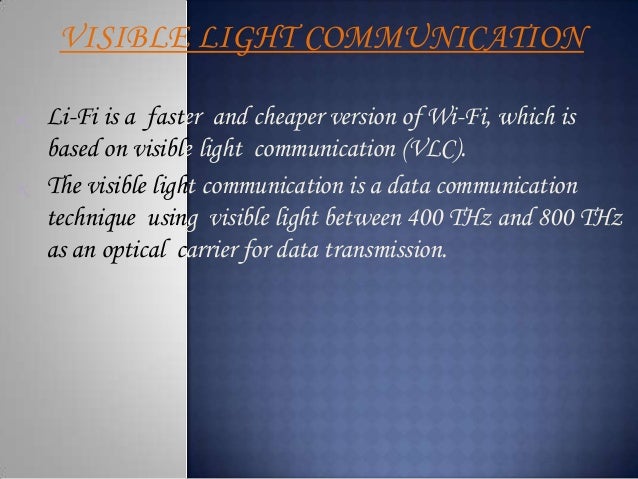WiFi
IEEE 802.11 considering LiFi as complement to WiFi
Executive Summary:
The Light Fidelity (LiFi) wireless protocol, which works from transmitters in light-emitting diode lamp bulbs, could function as a complement to Wi-Fi connectivity by offering faster internet access for mobile devices. The IEEE 802.11 standards committee is collecting industry feedback on a potential Li-Fi standard as noted in the section below.
Li Fi is an emerging wireless protocol that uses visible light spectrum to provide wireless networking access. A Li-Fi transmitter uses LED lights to modulate light intensity – mostly beyond what our eyes can perceive – and that is read as data by a photosensitive receiver. Because LEDs already use a chip to control their output they can modulate up to millions of times per second, theoretically allowing them to transmit data up to 100 times faster than Wi-Fi.
![fig(i)..Sending of data [2]](https://image.slidesharecdn.com/li-filatest-131027005455-phpapp02/95/li-fi-technology-6-638.jpg?cb=1382835371)
IEEE 802.11 Standards Status of LiFi:
IEEE 802.11 notes on the Topic Interest Group (TIG) page, “The introduction of light emitting diodes (LED) for general purpose lighting has created a growing interest in using the visible light spectrum for wireless communications……It is felt that the IEEE 802.11 is the best forum to drive forward the global standardization efforts for light communications with manufacturers, operators and end customers all present during the standardization process. If the TIG should progress to a Study Group and eventually into a Task Group, then this will not only help users within home, enterprise and industrial environments, but also assist manufacturers and operators to provide common components and services for IEEE 802.11 customers.”
At their July 2017 meeting, the IEEE 802.11 LC TIC unanimously recommended the continuation of the LiFi work via formation of a 802.11 LC Study Group. Hence, the 802.11 standards body is still seeking contributions before LiFi can become an official IEEE 802 standards project.
………………………………………………………………………………………………………..
Light Communications (LC) use cases:
-
Enterprise
-
Data access: where network connections are based on LC for daily work, conference streaming remote desktops along with potential video, etc. Enhanced data security can be achieved for organizations that require high level of confidentiality. The directionality of light propagation can effectively reduce interferences in heavily populated offices. Wireless off-loading to light releases spectrum for connecting other devices.
-
Use cases for RF sensitive facilities: for RF sensitive facilities such as hospital and mining, LC can provide safe data access where RF may not be allowed.
-
-
Home
-
Data access: where mobile devices use LC for high data rate network access. Especially for heavily populated apartments so that reduced interference and enhanced privacy can be achieved.
-
Home theater: Indoor use cases where high definition video and audio equipment connect to a LC AP
-
Virtual reality (VR): use cases where VR goggles are connected to a LC AP
-
-
Retail
-
Currently, delivery of high-bandwidth data at particular points in store requires cabled connection, making these spots immobile. Alteration of retail space to enable new customer experiences is a key part of retailer strategy. High-bandwidth flexible retail space through LC enables cost reductions for retailers when modifying or refitting the space.
-
LC can offer high data density that can enable very-high bandwidth content streaming without fear of interference with other wireless resources.
-
……………………………………………………………………………………………………………………..

Sidebar: The Problem with WiFi & How LiFi Complements it
WiFi signals don’t travel far, especially through walls. WiFi routers, operating on the traditional 2.4 GHz band, reach up to 150 feet (46 m) indoors and 300 feet (92 m) outdoors. At 5 GHz, WiFi signals only reach 40 or 50 feet. The higher the frequency, the shorter the wavelength. Hence, there’s less range at the same sensitivity and transmit power for 5 GHz vs 2.4 GHz WiFi.
Also, WiFi is notoriously insecure and easy to spoof by hackers. And even with the bandwidth increases over the years, an access point can be overwhelmed rather easily when too many people try to access it at the same time.
Li-Fi is meant to complement, not replace, Wi-Fi. It will co-exist in devices like smartphones, tablets and laptops, which would require a special receiver and transmitter to send and receive Li-Fi signals. That would also require a special encoder/decoder chip to convert the light signal to data.
………………………………………………………………………………………………………………..
Analyst Opinion:
Will Stofega, program manager for mobile device technology and trends at IDC, says good luck with that.
“Getting any standard approved is tough,” he told Network World. “There is always an ecosystem and political interests to play out. I think overall it needs a lot of work, but it’s the most promising of the alternative connection technologies.”


